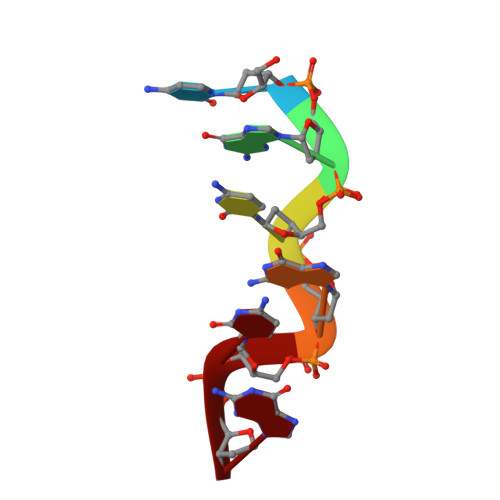N,N,O and N,O,N Meridional cis Coordination of Two Guanines to Copper(II) by d(CGCGCG)2.
Rohner, M., Medina-Molner, A., Spingler, B.(2016) Inorg Chem 55: 6130-6140
- PubMed: 27266259
- DOI: https://doi.org/10.1021/acs.inorgchem.6b00672
- Primary Citation of Related Structures:
4XQZ, 4XSN, 5IHD - PubMed Abstract:
Many research groups study the generation of supramolecular n-dimensional arrays by combining metals with DNA building blocks. Most of the time, the natural nucleobases are modified to obtain higher-affinity metal binding sites. Using unmodified nucleobases avoids a potentially difficult synthesis; however, they have the possible disadvantage of a less defined and/or weaker coordination mode of the metal. Structural studies on the behavior of copper(II) as a linking metal and guanine as the natural ligand for metals in unmodified DNA are reported. Previously, the ability of mono- and dinuclear metal complexes to induce Z-DNA has been explored [Medina-Molner, A.; Spingler, B. Chem. Commun. 2012, 48, 1961; Medina-Molner, A.; Rohner, M.; Pandiarajan, D.; Spingler, B. Dalton Trans. 2015, 44, 3664]. Herein, X-ray crystallographic studies of the structures resulting from the combination of copper(II) ions with DNA hexamers of the general sequence d(CG)3 are presented. Three different packing motifs were observed in three crystal structures with resolutions ranging from 2.15 to 1.45 Å. The motifs are dependent upon other cations being present and/or the crystallization conditions. The first examples of intramolecular O6,N7-chelates of a neutral purine nucleobase to copper(II) were obtained as well as the first meridional N,N,O and N,O,N coordination modes of two guanines to copper(II). The fascinating coordination chemistry of copper(II) complexes generated by the Z-DNA oligonucleotides and the differences to simple nucleobases complexes with copper(II) are discussed in detail.
Organizational Affiliation:
University of Zurich , Department of Chemistry, Winterthurerstrasse 190, 8057 Zurich, Switzerland.


















